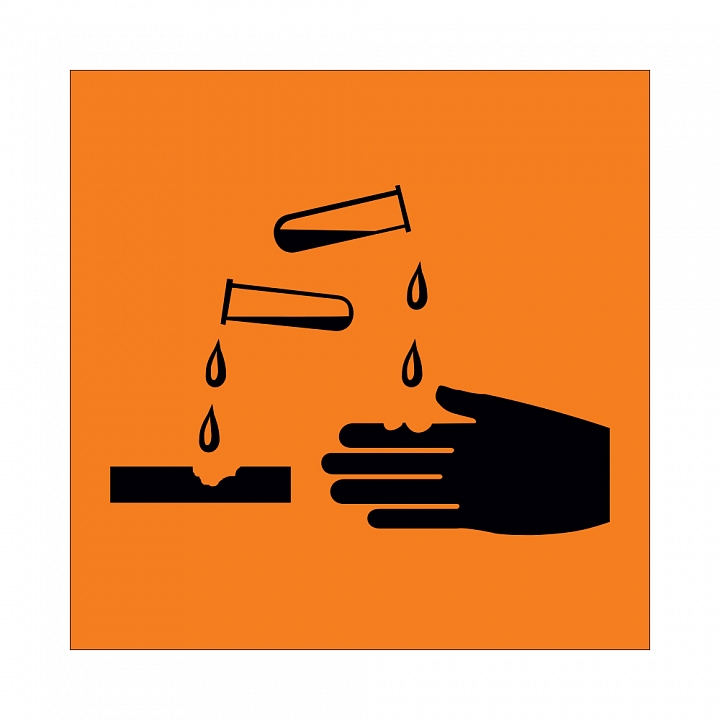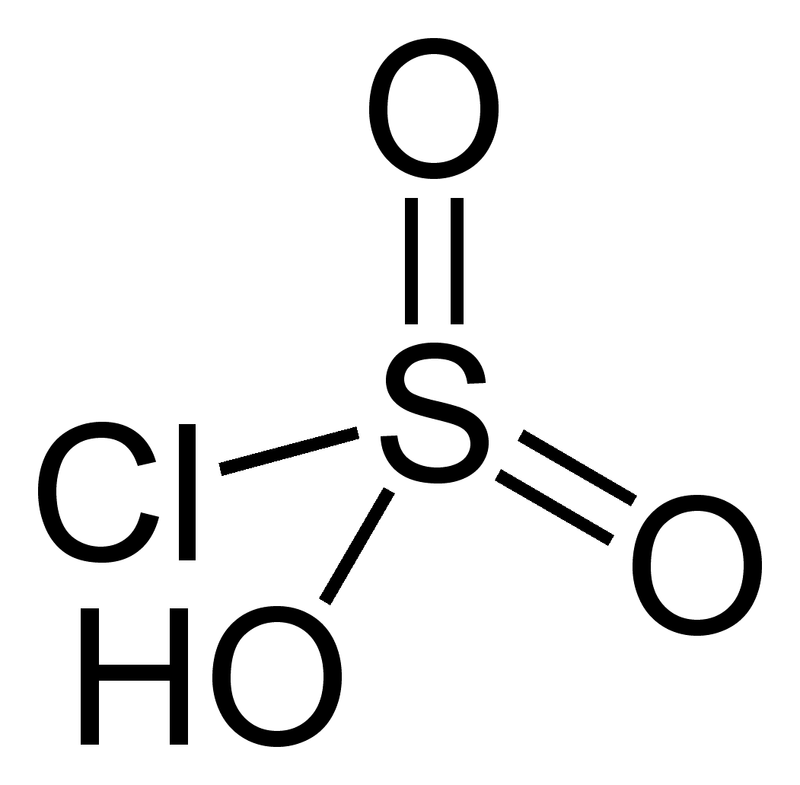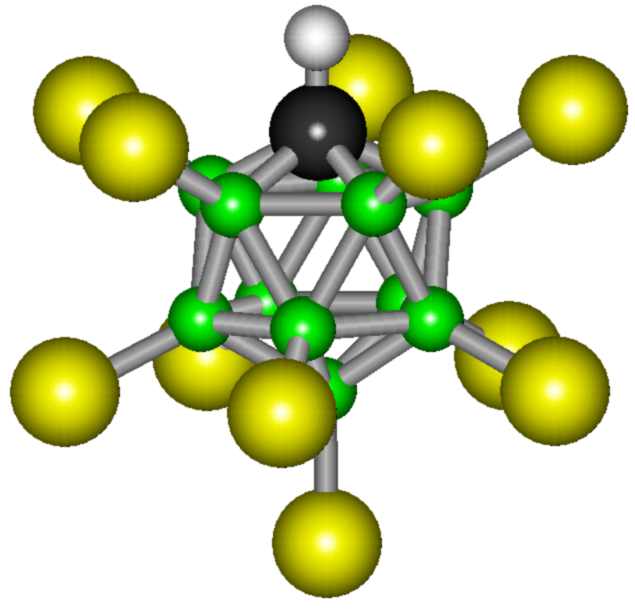Oh caustic and not very

- These idiots placed the porcelain container with the “jelly” in a special chamber, extremely isolated ... That is, they thought the camera was extremely isolated, but when they opened the container with the manipulators, the “jelly” went through metal and plastic, like water through a blotter, burst out outward, and everything with which he came into contact, again turned into a "jelly". Thirty-five people died, more than a hundred were mutilated, and the entire laboratory building was put into complete disrepair. Have you ever been there? Great building! And now the “jelly" stack in the basements and lower floors ... Here you have the prelude to the contact.
- A. Strugatsky, B. Strugatsky "Picnic on the sidelines"
Hello,% username%!
That I am still writing something - blame this man . He inspired an idea.
Just a little reflection, I decided that a short excursion on caustic substances will turn out relatively quickly. Maybe someone will be interested. And for someone - and it’s useful.
Go.
Immediately define the concepts.
Caustic - 1. Chemically corrosive. 2. A sharp, irritating, pain. 3. Acute, stabbing.
Ozhegov S.I. Dictionary of the Russian language. - M.: Rus.yaz., 1990 .-- 921 p.
So, we immediately discard the last two meanings of the word. We also discard the “caustic” lacrimators — which are not so much caustic as they cause tearing, and sternites — which cause coughing. Yes, there will be substances below that possess these properties, but they are what matters! - really corrode materials, and sometimes flesh.
We will not consider substances that are caustic only for humans and the like - in view of the specific destruction of cell membranes. And therefore mustards remain out of work.
We will consider compounds that are liquids in room conditions. Therefore, liquid oxygen and nitrogen, as well as gases such as fluorine, will not be considered, although they can be considered caustic, yes.
As usual, the view will be exclusively subjective, based on personal experience. And yes - it’s quite possible that I won’t mention anyone - write comments,% username%, within three days from the moment of publication I will supplement the article with something that was forgotten from the very beginning!
And yes - I don’t have the time and energy to build a “hit parade”, so there will be a hodgepodge. And with all the exceptions - she came out pretty short.
Caustic alkalis
Specifically, alkali metal hydroxides: lithium, sodium, potassium, rubidium, cesium, France, thallium (I) hydroxide and barium hydroxide. But:
- We discard lithium, cesium, rubidium and barium - it’s rare and expensive
- If you,% username%, encounter France hydroxide, then causticity will excite you last - it is terribly radioactive
- The same with thallium - it is poisonous to horror.
Therefore, sodium and potassium remained. But let's be honest - the properties of all caustic alkalis are very similar.
Sodium hydroxide is known to everyone as "caustic soda" (not to be confused with baking, soda and other soda, as well as potash). Potassium hydroxide as a food supplement E525 - too. Both are similar in properties: they are very hygroscopic, that is, they pull water, they “blur” in air. They dissolve well in water, and a large amount of heat is released.
“Spraying” in air is essentially the formation of very concentrated solutions of alkalis. And therefore, if you put a piece of caustic alkali on paper, leather, some metals (the same aluminum) - then over time it will be found that the material has eaten well! What was shown at the Fight Club is very similar to the truth: indeed, sweaty hands - yes into the alkali - it will hurt! Personally, it seemed to me more painful than from hydrochloric acid (about it below).
However, if the hands are very dry - most likely you will not feel anything in the dry alkali.
Caustic alkalis perfectly break down fats into glycerin and salts of fatty acids - and they cook soap (hi, “Fight Club!”) Slightly longer, but proteins are also effectively broken down - that is, in principle, alkalis dissolve the flesh, especially strong solutions - yes, when heated . The disadvantage in comparison with the same perchloric acid (about it also below) is that all alkalis pull carbon dioxide from the atmosphere, and therefore the strength will gradually decrease. In addition, alkalis also react with glass components - the glass becomes cloudy, although to dissolve it entirely - of course, one must try.
Tetraalkylammonium hydroxides are sometimes referred to caustic alkalis, for example
Tetramethylammonium hydroxide

In fact, the properties of cationic surfactants were combined in these substances (well, like ordinary soap, it’s only cationic: here the active diphilic particle has a charge of “+”, and in soap with a charge of “-”) and a relatively high basicity. If it gets into your hands, you can soap it in water and wash it with soap, if you warm your hair, skin or nails in an aqueous solution, it will dissolve. "Causticity" against the background of sodium and potassium hydroxides - so-so.
Sulfuric acid
H 2 SO 4
The most popular, probably, in all stories. Not the most caustic, but rather unpleasant: concentrated sulfuric acid (which is 98%) is an oily liquid that loves water very much and therefore takes it away from everyone. Taking water from cellulose and sugar, carbonizes them. In the same way, it will happily take away water from you,% username%, especially if you pour it on the delicate skin of your face or eyes (well, everything will actually get into your eyes with adventures). Particularly kind people interfere with sulfuric acid with oil, so that it is more difficult to wash off and absorb better into the skin.
By the way, taking water, sulfuric acid heats up great, which makes the picture even more juicy. So rinsing it off with water is a very bad idea. Better - oil (rinse, not rub - and then rinse with water). Well, or a large stream of water to immediately cool.
“First, water, and then acid - otherwise a big trouble will happen!” - this is about sulfuric acid, although for some reason everyone believes that about any acid.
Being an oxidizing agent, sulfuric acid oxidizes the surface of metals to oxides. And since the interaction of oxides with acids takes place with the participation of water as a catalyst - and sulfuric acid does not give up water - an effect called passivation occurs: a dense, insoluble and impermeable film of metal oxide protects it from further dissolution.
By this mechanism, concentrated sulfuric acid is sent to faraway iron and aluminum. It is noteworthy that if the acid is diluted, water appears, and it cannot be sent - the metals dissolve.
By the way, sulfur oxide SO 3 dissolves in sulfuric acid to produce oleum - which is sometimes mistakenly written as H 2 S 2 O 7 , but this is not entirely true. Oleum has even more thirst for water.
Own feelings of sulfuric acid on hand: a little warm, then a little bake - washed off under the tap, that's okay. Do not believe the movies, but I do not advise you to drip on your face.
Organics often use chrompeak or the “chromium mixture” —this is potassium dichromate, dissolved in sulfuric acid. In fact, this is a solution of chromic acid, it is good for washing dishes from the remnants of organic matter. When hit on the hand, it also burns, but in essence - sulfuric acid plus toxic hexavalent chromium. You can’t wait for a hole in your hand, except on clothes.
The author of these lines is familiar with the idiot who used potassium permanganate instead of potassium dichromate. Upon contact with organic chemistry, it a little gasped. Those present
By the way, since we remembered chrompeak - a little distraction from the topic of acids and
Chromium Chloride
CrO 2 Cl 2
In essence - a ferrous compound of hexavalent chromium and hydrochloric acid. The dark red liquid that draws water is hydrolyzed - and eventually smokes with this same hydrochloric acid. Caustic is the result of this fraternal unity: chromium - oxidizes, hydrochloric acid - dissolves: ignites some organic solvents (alcohol, turpentine), but dissolves in some (carbon tetrachloride, dichloromethane, carbon disulfide). It eats up metals, but not as good as acids - again, it is a matter of passivation. for example, steel, upon exposure, acquires a beautiful dark blue surface.
The skin - understandably - ulcerates, and the chrompike is stronger in this, since it penetrates better into the skin as into non-polar organic tissue. But this is not even the point, but hexavalent chromium, which is actually a carcinogen, and therefore penetrates deeper - more problems. And of course breathing in is much more dangerous.
Hydrochloric acid
HCl
Above 38% in water does not happen. One of the most popular acids for dissolution is that it is more abrupt than the others, because it can be technologically very pure, and in addition to acting as an acid, it also forms complex chlorides that increase solubility. By the way, it is for this reason that insoluble silver chloride is very soluble in concentrated hydrochloric acid.
When it gets on the skin, it burns a little harder, subjectively - it also itches, it also stinks: if you work a lot in the laboratory with poor extracts with concentrated hydrochloric acid, your dentist will say “thank you”: you will make it rich in fillings. By the way, chewing gum helps. But not much. Better - hood.
Since it is not oily and does not heat up much with water, causticity is only for metals, and even not for all. By the way, steel in concentrated hydrochloric acid is passivated and says “no!” To her. What they use during transportation.
Nitric acid
HNO 3
Also very popular, for some reason they are also afraid of it - but in vain. Concentrated - which is up to 70% - it is the most popular, higher - it is "smoking", most often nobody needs it. There is still waterless - so it also explodes.
Being an oxidizing agent, it passivates many metals that are coated with an insoluble film and say: “goodbye” - this is chromium, iron, aluminum, cobalt, nickel and others.
It immediately reacts with the skin on the principle of xanthoprotein reaction - there will be a yellow spot, which means that you,% username%, still consist of protein! After some time, the yellow skin peels off, like a burn. At the same time, it nibbles less than hydrochloric acid, although it stinks no worse - and this time it is more toxic: flying nitrogen oxides are not very good for the body.
In chemistry, the so-called "nitrating mixture" is used - the most popular consists of sulfuric and nitric acids. It is used in syntheses, in particular in obtaining a fun substance - pyroxylin. By causticity - the same chrompic plus beautiful yellow skin.
There is also “aqua regia” - this is part of nitric acid into three parts of hydrochloric acid. It is used to dissolve some metals, mainly precious ones. Based on a different ratio and the addition of water, the drip method of checking samples of gold products is based - by the way, it is very difficult for specialists in this method to fool around with a fake. In terms of causticity for the skin - the same “nitrating mixture” plus stinks perfectly, the smell cannot be confused with anything, it is also quite toxic.
There is also “reverse royal vodka” - when the ratio is the opposite, but this is a rare specificity.
By the way, about the very “smoking” one, which is red, evil and oxidizing - I quote the story of a good friend who sent me right now.
I drove this very 98% nitrogen. Either I just distilled it for cleaning, or from melange, I don’t remember. I caught up to two liters, I remove the receiver. I ask the laboratory assistant to give a clean flask of 2 liters - pour. She gave me a dry, clean, but from under the alcohol - and with a closed cork. That is, the pairs were and accumulated. I go there and pour a funnel. I will go there - and she will be back. She splashed well on her hands, on her face and below her neck. Sensation - like an eagle clutching its face. Plus arms, neck, nose, etc. on the little things. In my hands, I recall, two liters of the same good. Eyes closed naturally. I understand that you can’t drop the flask, it will be immediately worse. I carefully place the flask on a rubber stand, move to the sink, turn the gander in my face and turn on the full pressure. About five seconds managed. I did not reach subcutaneous tissue. Otherwise, everything would be much worse. I saw another man what happens after 10-15 seconds. Hard-healing scarlet scars on half of the hand. Then I realized why she was so angry. Not only is it a fairly strong acid and oxidizing agent, it is also a wonderful solvent. It mixes unlimitedly with water, but mixes unlimitedly with, for example, dichloroethane. Such a biphilic rubbish.
Phosphoric acid
H 3 PO 4
In fact, I gave the formula of phosphoric acid - the most common. And there is also metaphosphoric, polyphosphoric, ultraphosphoric - in short, enough, but not important.
Concentrated phosphoric acid (85%) is such a syrup. The acid itself is average, it is often used in the food industry, by the way - when fillings are placed on you, the tooth surface is first etched with phosphoric acid.
She has corrosion so-so, but there is an unpleasant nuance: this syrup is well absorbed. Therefore, if it drips onto things, it will be absorbed, and then it will slowly erode. And if there is a stain or a hole from nitric and hydrochloric acid, then the thing will come apart from the phosphoric thing, especially it is colorful on shoes, when the hole crumbles, as it were, until it works through.
Well, in general it is difficult to call it caustic.
Hydrofluoric acid
HF
Concentrated hydrofluoric acid is about 38%, although there are strange exceptions.
Weak acid, which takes the fluoride ions with violent love, to form stable complexes with everything you can. Therefore, it surprisingly dissolves what other, more powerful friends cannot, and therefore it is very often used in different mixtures for dissolution. If you get it on hand, the sensations will be more from other components of such mixtures, but there is a nuance.
Hydrofluoric acid dissolves SiO 2 . That is sand. That is glass. That is quartz. Well and so on. No, if you put acid on the window, it will not dissolve, but the cloudy spot will remain. To dissolve - you need to hold for a long time, and even better - heat. When dissolved, SiF 4 is released, which is so good for health, that it’s better to do it under the hood.
A small but pleasant nuance: you have silicon,% username%, in your nails. So, if hydrofluoric acid gets under the nails - you will not notice anything. But you won’t be able to sleep at night - it will hurt SO that sometimes there is a desire to lift your finger. Believe me, friend - I know.
In general, hydrofluoric acid is toxic, carcinogenic, is absorbed through the skin and the mass of everything - but today we are talking about causticity, right?
Remember, we agreed at the very beginning that there would be no fluoride? He will not be. But they will ...
Inert Gas Fluorides
In fact, fluorine is a stern guy, you don’t have much fun with it, and therefore some inert gases form fluorides with it. Such stable fluorides are known: KrF 2 , XeF 2 , XeF 4 , XeF 6 . All these are crystals that decompose in air at different speeds and readily by moisture to hydrofluoric acid. Causticity is appropriate.
Hydroiodic Acid
HI
The strongest (according to the degree of dissociation in water) binary acid. Strong reducing agent used by organic chemists. It oxidizes in air and becomes brown, which is why it gets dirty on contact. Sensations at contact - as from hydrochloric. All.
Perchloric acid
HClO 4
One of the strongest acids (in terms of degree of dissociation in water) in general (super acids compete with it - more about them below) is Hammett's acidity function (a numerical expression of the ability of a medium to be a proton donor with respect to an arbitrary base, the smaller the stronger the acid) is -13. Anhydrous is a strong oxidizing agent, likes to explode, and is generally unstable. Concentrated (70% -72%) - the oxidizing agent is no worse, often used in the decomposition of biological objects. The decomposition is interesting and exciting in that it can explode in the process: you need to make sure that there are no particles of coal, that it does not boil too violently, etc. Perchloric acid is also rather dirty - it cannot be cleaned by sub-distillation, the infection explodes! Therefore, they use it infrequently.
When it gets on the skin, it burns, it feels like hydrochloric. It stinks. When you see in films that someone threw a corpse into a container with perchloric acid - and it dissolved, then yes, this is possible - but for a long time or to warm. If heated, it can jerk (see above). So be critical of the cinema (I seem to have seen this in Cloverfield 10).
By the way, the causticity of chlorine oxide (VII) Cl 2 O 7 and chlorine oxide (VI) Cl 2 O 6 is the result of the formation of perchloric acid with water.
Now imagine that we decided to combine strong acidity - and fluoride causticity in one compound: take a molecule of perchloric or sulfuric acid - and replace all the hydroxyl groups on it with fluorine! The rubbish will turn out rare: it will interact with water and similar compounds - and at the site of the reaction, strong acid and hydrofluoric acid will immediately be obtained. A?
Sulfur, bromine and iodine fluorides
Remember, we agreed to consider only liquids? For this reason, our article did not get ClF 3 chlorine trifluoride , which boils at +12 ° C, although all the horror stories that it is terribly toxic ignites glass, a gas mask and spills 900 kilograms - it consumes 30 cm of concrete and a meter of gravel - all this is true. But we agreed - liquids.
However, there is a yellow liquid - iodine pentafluoride IF 5 , a colorless liquid - bromine trifluoride BrF 3 , light yellow - bromine pentafluoride BrF 5 , which are no worse. BrF 5 , for example, also dissolves glass, metals and concrete.
Similarly, among all sulfur fluorides, onlydisye decafluoride (sometimes called sulfur pentafluoride) is a colorless liquid with the formula S 2 F 10 . But this compound is quite stable at ordinary temperatures, does not decompose by water - and therefore not particularly caustic. True, 4 times more toxic than phosgene with a similar mechanism of action.
By the way, they say that iodine pentafluoride was a “special gas” for filling the atmosphere in the rescue shuttle in the last frames of the 1979 film “Alien”.
I even found, took a closer look and realized that Ripley lived there in such harsh conditions that an alien beast is just a sweetheart

Super Acids
The term “superacid” was coined by James Conant in 1927 to classify stronger acids than regular mineral acids. In some sources, perchloric acid is referred to as super acid, although this is not so - it is a common mineral acid.
A number of superacids are mineral ones, to which halogen was picked up: halogen pulls electrons on itself, all atoms are very angry, and everything goes as usual to hydrogen: it falls off in the form of H + - broads: here the acid has become stronger.
Examples - fluorosulfuric and chlorosulphuric acids



For fluorosulfuric acid, Hammett's function is -15.1, by the way, due to fluorine, this acid gradually dissolves the test tube in which it is stored.
Then one of the smart ones thought: let's take Lewis acid (a substance that can take a pair of electrons of another substance) and mix it with Bronsted acid (a substance that can give off a proton)! Antimony pentafluoride was mixed with hydrofluoric acid to obtain HSbF 6 hexafluorosulfuric acid . In this system, hydrofluoric acid releases a proton (H + ), and the conjugated base (F - ) is isolated by coordination with antimony pentafluoride. This forms a large octahedral anion (SbF 6 -), which is a very weak nucleophile and a very weak base. Having become "free", the proton determines the super-acidity of the system - Hammett’s function -28!
And then others came and said, why did they take weak acid from Bernsted - and they came up with this.
Trifluoromethanesulfonic Acid

- itself is already super acid (Hammett function -14.1). So, they added antimony pentafluoride to it again - they got a reduction to -16.8! The same focus with fluorosulfuric acid gave a decrease to -23.
And then a group of scientists from the chemical department of the American University of California, led by Professor Christopher Reed, hung out with colleagues from the Institute of Catalysis of the SB RAS (Novosibirsk) and came up with carboranic acid H (CHB 11 Cl 11 ). Well, it’s called “carboranova” for ordinary people, and if you want to feel like a scientist, say “2,3,4,5,6,7,8,9,10,11,12-undechlor-1-carba-closo-dodecaboran (12) ”three times and quickly.
So this beauty looks

It is a dry powder that is soluble in water. This is the Strongest Acid at the moment. Carboranic acid is about a million times stronger than concentrated sulfuric acid. It is not possible to measure the strength of the acid on ordinary scales, since the acid protonates all known weak bases and all solvents in which it dissolves, including water, benzene, fullerene-60, sulfur dioxide.
Subsequently, Christopher Reed, in an interview with Nature News Service, said: “The idea of synthesizing carboranic acid was born out of fantasies about molecules never created before.” Together with his colleagues, he wants to use carboranic acid to oxidize xenon inert gas atoms - simply because no one has done this before. Original, what to say.
Well, since superacids are ordinary acids, they usually act, only a little stronger. It is clear that the skin will be burned, but this does not mean - what to dissolve. Fluorosulfonic is a separate case, but everything is there thanks to fluorine, as in hydrofluoric.
Trihaloacetic Acids
Namely, trifluoroacetic and trichloroacetic acid



Nice and pleasant combination of the properties of an organic polar solvent and a sufficiently strong acid. Stink - like vinegar.
The sweetest thing is trifluoroacetic acid: a 20% solution destroys metals, cork, rubber, bakelite, and polyethylene. It burns on the skin and forms dry ulcers, reaching the muscle layer.
Trichloroacetic in this regard is the younger brother, but nothing too. By the way, applause to the weaker sex: in pursuit of beauty, some go to the so-called TCA peeling procedure (TCA is TetraChloroAcetate) - when the upper coarse layer of the skin is dissolved with this same trichloroacetic acid.
True, if the beautician chatted on the phone, it is possible to file

Acetic acid
CH 3 COOH
Most likely, you have this acid in the kitchen - and yes, it is used as a food supplement E260. But it also happens stronger - a 70-80% aqueous solution of acetic acid is called acetic essence, and if the concentration is close to 100% - glacial acetic acid (because it can freeze and form something similar to ice.
Acetic acid is not as caustic in relation to metals as mineral acids, but since it is not so polar, and to some extent even diphilic (the combination of the hydrophobic and hydrophilic parts in one molecule - as in surfactants) - it’s great absorbed by the skin. Hazardous solutions are those with a concentration of acetic acid greater than 30%. The peculiarity of burns is that the development of coagulation necrosis of adjacent tissues of various lengths and depths is also initiated - if not washed off, there will be long healing ulcers and scars.
Well, she stinks, of course, notably.
Formic acid
UNSOO
We have already discussed that formic acid, which is formed in the body after taking methanol, is one of the main causes of its toxicity. So, formic acid from the outside is not at all so dangerous, because it is rapidly metabolized and excreted by the body. Toxicity is quite low - for rats LD 50 about 1.8 g / kg, and therefore formic acid is also often used, including as a food supplement - and this should not be afraid.
The "causticity" of formic acid depends on the concentration. According to the European Union classification, up to 10% has an irritating effect, more than 10% is corrosive. And again, it’s not about metals and glass, but about the body. When it comes into contact with the skin, it’s 100% liquid formic acid causes severe chemical burns, even a small amount on the skin causes severe pain, the affected area first turns white, as if covered with hoarfrost, then it becomes like wax, a red border appears around it. cut the fat layer of the skin, therefore, washing the affected area with a soda solution must be done immediately, so the ants really know something.
Bromine
Br 2
Heavy caustic liquid of red-brown color with a strong unpleasant odor, vaguely reminiscent of the smell of both iodine and chlorine. By the way, the name “bromine” from the Greek βρῶμος is “stinky”, “stinky”.
Bromine is a typical halogen; in terms of chemical activity, bromine occupies an intermediate position between chlorine and iodine. That is, not as quick as fluorine - but more alive than boring iodine. And yes, it also falls short of chlorine.
Slightly soluble in water, good in some organic solvents. Bromine water - a reagent for unsaturated hydrocarbons - stinks, but it’s completely peaceful and does not dissolve anything.
Pure bromine is
Concrete and glass to bromine are quite stable. Organic compounds with bromine - what? - right! - brominated in the presence of an unsaturated bond. For this reason, the stability of polymers depends on their type, for example, polyethylene and polypropylene - they wanted to spit on bromine under room conditions.
Hydrogen peroxide
H 2 O 2 An
unstable compound that constantly breaks down into oxygen and water. The higher the concentration, the more unstable that gradually turns into an explosion hazard. To stabilize technical hydrogen peroxide, pyrophosphate or sodium stannate is added to it; when stored in aluminum containers use a corrosion inhibitor - ammonium nitrate.
Hydrogen peroxide in a laboratory is usually a 38% solution. On contact with the skin, it causes a chemical burn with a characteristic white color. The burn is painful, especially on thin skin, whitened keratinized skin then often crack and itch.
In medicine, 3% hydrogen peroxide is used to clean deep wounds of a complex profile, purulent streaks, phlegmon and other purulent wounds, the rehabilitation of which is difficult - so the substance has not only an antiseptic effect, but also creates a large amount of foam when interacting with the enzyme catalase. This in turn allows you to soften and separate from the tissue necrotic areas, blood clots, pus, which will be easily washed away by the subsequent introduction of an antiseptic solution into the wound cavity. By the way, hydrogen peroxide is undesirable in other cases of wounds: having good cleansing properties, this substance does not actually accelerate the healing process, since it damages cells adjacent to the wound, as well as young, newly formed tissues - and this is also fraught with the formation of scars.
Except for burns on the skin, it does not corrode or dissolve anything. Metals, glass and plastics are resistant to hydrogen peroxide.
And hydrogen peroxide gave the world a lot of unique natural blondes with black hair roots!
The so-called peracids are close to hydrogen peroxide - acids in which peroxide groups are present. Example: peracetic acid CH 3 COOON - a substance that resembles hydrogen peroxide in terms of properties, and therefore is used in exactly the same areas. There is a “first-blood” or “C-4” (no, this is not the C-4 you were thinking about) - it is HCOOON permic acid , which is even weaker than peracetic acid , and therefore hiriruga wash her hands before surgery. And finally - trifluorooracetic acid CF 3UNSD is a fierce, rabid oxidizing agent, which organic chemists look with admiration for the possibility of oxidizing aniline to nitrobenzene, obtaining hypervalent iodine in organic compounds, the Bayer-Williger reaction, and other things that are obscure to normal people. By causticity - trifluoroacetic acid mixed with hydrogen peroxide, which, in fact, is, and therefore poses a special danger to hands, yes. In view of its high oxidizing ability, trifluorooracetic acid is not sold, but is usually obtained by admiring organic chemists right where necessary by the interaction of trifluoroacetic anhydride with hydrogen peroxide.
Well, something like this, if we talk about liquid and causticity. Will there be more additions?
